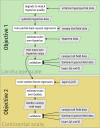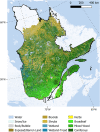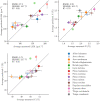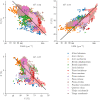Mapping canopy traits over Québec using airborne and spaceborne imaging spectroscopy
- PMID: 37821515
- PMCID: PMC10567784
- DOI: 10.1038/s41598-023-44384-0
Mapping canopy traits over Québec using airborne and spaceborne imaging spectroscopy
Abstract
The advent of new spaceborne imaging spectrometers offers new opportunities for ecologists to map vegetation traits at global scales. However, to date most imaging spectroscopy studies exploiting satellite spectrometers have been constrained to the landscape scale. In this paper we present a new method to map vegetation traits at the landscape scale and upscale trait maps to the continental level, using historical spaceborne imaging spectroscopy (Hyperion) to derive estimates of leaf mass per area, nitrogen, and carbon concentrations of forests in Québec, Canada. We compare estimates for each species with reference field values and obtain good agreement both at the landscape and continental scales, with patterns consistent with the leaf economic spectrum. By exploiting the Hyperion satellite archive to map these traits and successfully upscale the estimates to the continental scale, we demonstrate the great potential of recent and upcoming spaceborne spectrometers to benefit plant biodiversity monitoring and conservation efforts.
© 2023. Springer Nature Limited.
Conflict of interest statement
The authors declare no competing interests.
Figures






References
-
- Ma S, He F, Tian D, Zou D, Yan Z, Yang Y, Zhou T, Huang K, Shen H, Fang J. Variations and determinants of carbon content in plants: A global synthesis. Biogeosciences. 2018;15(3):693–702. doi: 10.5194/bg-15-693-2018. - DOI
-
- Zhao H, Xu L, Wang Q, Tian J, Tang X, Tang Z, Xie Z, He N, Yu G. Spatial patterns and environmental factors influencing leaf carbon content in the forests and shrublands of China. J. Geograph. Sci. 2018;28(6):791–801. doi: 10.1007/s11442-018-1505-x. - DOI
Publication types
MeSH terms
LinkOut - more resources
Full Text Sources

